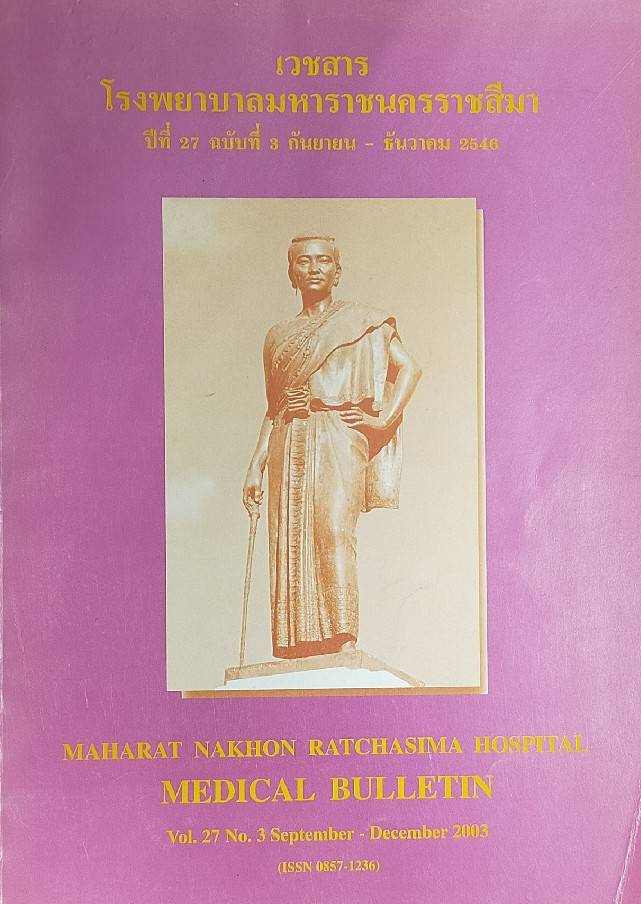การป้องกันความดันโลหิตต่ำด้วยวิธีหนุนสะโพกให้เอียงซ้ายและฉีด Ephedrine เข้าหลอดเลือดดำ ในผู้ป่วยผ่าท้องคลอดที่ได้รับยาระงับความรู้สึกเฉพาะที่ชนิดฉีดเข้าช่องไขสันหลัง ในโรงพยาบาลมหาราชนครราชสีมา
Main Article Content
บทคัดย่อ
ภูมิหลัง: การให้ยาระงับความรู้สึกเฉพาะที่ชนิดฉีดยาเข้าช่องไขสันหลังในผู้ป่วยผ่าท้องคลอดเป็นวิธีที่ทำง่าย แต่จะมีปัญหาของความดันโลหิตต่ำได้บ่อย อาจป้องกันได้โดยการให้สารน้ำยากระตุ้นหลอดเลือดตีบทางหลอดเลือดดำและหนุนสะโพกเอียงซ้าย วัตถุประสงค์: เพื่อศึกษาถึงผลของการใช้ยา enhedrine และการนอนเอียงซ้ายทำมุม 15-30 องศาในการป้องกันภาวะความดันเลือดต่ำ ผู้ป่วยและวิธีการ: ผู้ป่วยผ่าตัดคลอดจำนวน 80 ราย ที่ได้รับยาระงับความรู้สึกเฉพาะที่ชนิดฉีดเข้าไขสันหลัง โดยแบ่งเป็น 2 กลุ่ม กลุ่มละ 40 ราย คือกลุ่มทลองจะให้ยา ephedrine 6 มิลลิกรัม ทางหลอดเลือดดำและหนุนสะ โพกเอียงซ้าย 15 องศา ทันทีหลังทำการให้ยาระงับความรู้สึกเฉพาะที่ชนิดฉีดยาเข้าช่องไขสันหลังและกลุ่มควบคุมไม่ได้ให้ยา ephedrine และไม่ได้หนุนสะ โพกเอียงซ้าย หลังทำการให้ยาระงับความรู้สึกเฉพาะที่ชนิดฉีดยาเข้าช่องไขสันหลัง เปรียบเทียบข้อมูลทั่วไป ภาวะความดัน โลหิตต่ำ จำนวนสารละลายน้ำที่ให้และจำนวนยา ephedrine ที่ให้ระหว่างผ่าตัด ผลการศึกษา : ในกลุ่มควบคุมมีผู้ที่มีภาวะความดันเลือดต่ำมากกว่าในกลุ่มทดลองถึง 2.9 เท่า (ร้อยละ 100 กับร้อยละ 35) ทั้งจำนวน ephedrine และสารน้ำที่ให้ทำการให้ยาระงับความรู้สึกเฉพาะที่ชนิดฉีดยาเข้าช่องไขสันหลัง ในกลุ่มควบคุมต่างก็มากกว่าในกลุ่มทดลองอย่างมีนัยสำคัญทางสถิติ (ความน่าจะเป็น < 0.001) สรุป: การให้ยา ephedrine 6 มิลลิกรัม เข้าหลอดเลือดดำเเละหนุนสะโพกเอียงซ้าย 15 องศาทันทีหลังให้ยาระงับความรู้สึกเฉพาะที่ชนิดฉีดยาเข้าช่องไขสันหลัง อาจจะช่วยลดภาวะความดันเลือดต่ำ
Article Details

อนุญาตภายใต้เงื่อนไข Creative Commons Attribution-NonCommercial-NoDerivatives 4.0 International License.
เอกสารอ้างอิง
Santos AC, Pederson H, Finster M. Obstetric anesthesia. In: Barash PG,CullenBF , Stoelting RK, editors. Clinical anesthesia 3rd ed. Philadelphia: Lippincott-Raven 1997; p 1061-90.
Riley ET, Cohen SE, Rubenstein AJ, Flanagan B. Prevention of hypotension after spinal anesthesia for caesarean section: six percent hetastarch versus lactated Ringer's solution. Anesth Analg 1995; 81: 838-42.
Chan WS,Irwin MG, Tong WN, Lajm YH. Prevention of hypotension during spinal anesthesia for caesarean section: ephedrine infusion versus fluid preload. Anesthesia 1997; 52: 896-913.
ThomasDG, RobsonSC, Redfern N, HughesD, Boys RJ. Randomized trial of bolus phenylephrine or ephedrine for maintenance of arterial pressure during spinal anaes- thesia for caesarean section. Br J Anaesth 1996; 76 : 61-5.
Vincent RD, Werhan CF, Norman PF, Shih GH, Chestnut DH, Ray T,et al. Propbylactic angiotensin Il infusion during spinal anesthesia for elective caesarean delivery. Anesthesiology 1998; 88: 1475-9.
Ramin SM, Ramin KD, Cox K, MagnessRR, Shearer VE,Gant NF.Comparison of prophylactic angiotensin II versus ephedrine infusion for prevention of maternal hypotension during spinal anesthesia. Am J Obster Gynecol 1994;171:734-9.
Bhagwanjee S, Rocke DA, Rout CC, Koovarjee RV, Brijball R. Prevention of hypotension following spinal anaesthesia for elective caesarean section. By wrapping of the legs. Br J Anaesth 1990; 65: 819-22.
Hughes SC, Levinson G, Rosen MA. Anesthesia for Cesarean Section. In: Levinson G, Schanider and Levinson's Anesthesia for Obstetrics. 4th ed. Philadelphia: Lippincott Williams & Wilkin; 2001; p 204-24.
Kangas-Saarela T, Hollmen AI, Tolonen U, Eskelihen P, Alahuhta S, Jouppila R, et al. Does ephedrine influence newborn neurobehavioral responses and spectral EEG when used prevent maternal hypotension during cesarean section ? Acta Anaesthesiol Scand 1990; 34: 8-16.
Gutsche BB. Prophylactic ephedrine preceding spinal analgesia for cesarean section. Anesthesiology 1976; 45: 462-5.


